23 Types of Orange Flowers For Your Garden
Photo by: ADD / Pixabay.
25 Best Plants with Orange Flowers
Bold and fiery, orange flowers can’t help but be noticed and command attention wherever you plant them. Although these outgoing bloomers are far from shy, they are more versatile than you might think and deserve a place in the garden in every season. Usher in spring with the dazzling glow of orange-blooming Oriental poppies. Add sizzle to the summer garden with orange zinnias and marigolds. And celebrate the warm colors of fall with container plantings of orange pansies or mums. As long as orange is used judiciously, there is no better color to add spark to a humdrum garden and bring it back to life.
On this page:
ANNUALS WITH ORANGE FLOWERS
Superbells® Double Orange calibrachoa. Photo by: Proven Winners.
CALIBRACHOA
Superbells® Double Orange — Buy now from Proven Winners
(Calibrachoa hybrids)
Exposure: Full sun to partial shade
Bloom time: Planting to hard frost
Height/Spread: 6 to 12 inches tall, 12 to 24 inches wide
Petite petunia-like flowers, accented by dark orange veining, look stunning trailing from containers and hanging baskets. For the best display, give plants a light trim on occasion to encourage fuller growth and more abundant flowering. Learn more about growing calibrachoa.
‘Flamma Orange’ celosia. Photo by: All America Selections.
CELOSIA
Exposure: Full sun
Bloom time: Summer through fall
Height/Spread: 1 to 3 feet tall, 6 to 18 inches wide
These heat-loving flowers come in a variety of eye-catching forms, ranging from feathery plumes to crested cockscombs, in vibrant shades of orange, red, yellow, and pink. One of the newest cultivars is ‘Flamma Orange,‘ an All-America Selections winner lauded for its fade-resistant fiery orange plumes and long season of bloom.
Vermillionaire® large firecracker plant. Photo by: Proven Winners.
CUPHEA
Vermillionaire® — Buy now from Proven Winners
(Cuphea hybrids)
Zones: Usually grown as an annual; perennial in Zones 8-11
Exposure: Full sun
Bloom time: Planting until frost
Height/Spread: 18 to 28 inches tall, 12 to 24 inches wide
Clusters of orange, tubular-shaped flowers with yellow tips look like tiny firecrackers, bringing an explosion of color to containers and garden beds. Irresistible to hummingbirds, cuphea requires no deadheading for continuous bloom. Learn more about growing cuphea.
Photo by: Andrew Shepetov / Shutterstock.
GERBERA DAISY
Zones: Usually grown as an annual; perennial in Zones 8-11
Exposure: Full sun to partial shade
Bloom time: Late spring through fall
Height/Spread: 8 to 12 inches
The daisy-like flowers of gerberas bloom in nearly every color, from soft pastels to zesty shades of orange and red. Varieties to try include ‘Mega Revolution Orange,’ which features deep orange petals surrounding cream-colored centers, and ‘Patio Volcanoes,’ which has large orange and yellow bi-color blooms with black eyes. Learn more about growing Gerbera daisies.
Infinity® Orange New Guinea impatiens. Photo by: Proven Winners.
IMPATIENS
Infinity® Orange — Buy now from Proven Winners
(Impatiens hawkeri)
Zones: Usually grown as an annual; perennial in Zones 8-11
Exposure: Shade to partial sun
Bloom time: Planting to frosts
Height/Spread: 10 to 14 inches tall, 6 to 12 inches wide
Looking for an orange bloomer to bring vibrant, nonstop color to a shady corner? This tough, mildew-resistant impatiens is adaptable to most light conditions and features extra-large flowers that pop against dark-green foliage. Learn more about growing impatiens.
Photo by: Bruno Glatsch / Pixabay.
MARIGOLD
Exposure: Full sun
Bloom time: Late spring until frost
Height/Spread: 6 inches to 4 feet tall, 6 inches to 2 feet wide, depending on the variety
This no-fuss annual comes in numerous shades of orange and yellow, often with striking highlights of red, gold, or bronze. In addition to its ornamental value, marigold is a great companion plant in a vegetable garden because it helps repel unwanted pests. Learn more about growing marigold flowers.
‘Matrix Orange’ pansy. Photo by: Jana Milin / Shutterstock.
PANSY
Zones: Usually grown as an annual; perennial in Zones 8-11
Exposure: Full sun to partial shade
Bloom time: Spring, fall, early winter
Height/Spread: 6 to 9 inches tall, 9 to 12 inches wide
Although pansies are best known for their cheery purple or yellow flowers, you can also find pretty cultivars with orange blooms, such as ‘Frizzle Sizzle Orange,’ which has ruffled pumpkin-orange flowers, or ‘Matrix Orange,’ which sports extra-large bright orange blossoms. Where winters are mild, pansies planted in fall will often rebloom again in spring. Learn more about growing pansies.
‘Queeny Lime Orange’ zinnia. Photo by: All America Selections.
ZINNIA
Exposure: Full sun
Bloom time: Late spring until frost
Height/Spread: 1 to 4 feet tall, 1 to 2 feet wide
Put some zing into your zinnia patch by including some bright orange bloomers, like ‘Double Zahara Fire’, which sports fully double scarlet-orange blooms, or the more demure ‘Queeny Lime Orange’, a beautiful blend of salmon, orange, peach, and lime. One of the easiest annuals to start from seed, zinnias can be sown directly in the garden after the threat of frost has passed. Learn more about growing zinnias.
PERENNIALS WITH ORANGE FLOWERS
Photo by: ADD / Pixabay.
BIRD OF PARADISE
Zones: 10-12
Exposure: Full to partial sun
Bloom time: Late winter to summer, with year-round bloom under optimal growing conditions.
Named for its iridescent orange and blue flowers that resemble a bird in flight, this exotic tropical perennial craves heat and grows best in outdoor temperatures over 60 degrees F. But even if you live in a colder climate, you can enjoy this spectacular plant year-round by potting it up and growing it indoors over winter in a sunny room. Learn more about growing bird of paradise plants.
Arizona Apricot blanket flower. Photo by: Proven Winners.
BLANKET FLOWER
Arizona Apricot — Buy now from Proven Winners
(Gaillardia spp.)
Zones: 3-10
Exposure: Full sun
Bloom time: Early summer to fall
Height/Spread: 12 inches tall and wide
Large apricot-orange blooms with yellow tips cover tidy mounds of dark green foliage for months on end, bringing long-lasting color to garden beds and borders. This heat- and drought-tolerant prairie native needs little care once established, and the nectar-rich flowers are magnets for butterflies and bees. Learn more about growing blanket flower.
Photo by: Proven Winners.
BUTTERFLY WEED
Butterfly weed — Buy now from Proven Winners
(Asclepias tuberosa)
Zones: 3-9
Exposure: Full sun
Bloom time: Late spring through late summer
Height/Spread: 1 to 2 feet tall, 12 to 18 inches wide
Bearing clusters of bright orange blossoms, this showy cousin of milkweed is a vital food source for monarchs and other butterflies and a beautiful addition to a meadow or pollinator garden. Deadhead faded flowers to encourage more blooms and to prevent the plant from reseeding if you wish to limit its spread.
Orange Zest chrysanthemum. Photo by: Proven Winners.
CHRYSANTHEMUM
Zones: 7-9
Exposure: Full sun
Bloom time: Late summer through fall
Height/Spread: 14 to 24 inches tall, 20 to 36 inches wide
Available in a wide array of rich, autumnal shades like coppery orange, russet, and burgundy, the garden mum is often used as a fall annual to replace summer-blooming plants in containers and garden beds. Many varieties can also be grown as perennials if you plant them in early spring or at least 6 weeks before a killing frost in fall. Learn more about growing mums.
Color Coded™ ‘Raspberry Beret’ coneflower. Photo by: Proven Winners.
CONEFLOWER
Color Coded® ‘Orange You Awesome’ — Buy now from Proven Winners
(Echinacea hybrids)
Zones: 4-8
Exposure: Full sun to partial shade
Bloom time: Mid to late summer
Height/Spread: 18 to 22 inches tall, 16 to 20 inches wide
A nice change of pace from the familiar purple coneflower, this compact cultivar features large tangerine-orange flowers enhanced by a hint of magenta near the cone. Once the flowers have finished blooming, leave the seed heads in place to attract a multitude of songbirds to your garden. Learn more about growing coneflower.
Luscious® Marmalade lantana. Photo by: Proven Winners.
LANTANA
Luscious® Marmalade — Buy now from Proven Winners
(Lantana camara)
Zones: 9-11, grown as an annual elsewhere
Exposure: Full sun
Bloom time: From planting until frost
Height/Spread: 20 to 30 inches tall and wide
A beautiful blend of deep orange, yellow, and red, this heat-tolerant bloomer flowers nonstop from late spring until frost and nearly year-round in warmer climates. Usually grown as an annual in cooler climates. A nice, mounded habit makes it a perfect choice for containers, borders, and mass plantings. Learn more about growing lantana.
Photo by: Dajra / Shutterstock.
ORIENTAL POPPY
Zones: 5-7
Exposure: Full sun
Bloom time: Spring to early summer
Height/Spread: 2 to 4 feet tall, up to 2 feet wide
Although their time in the spotlight is brief, the crepe papery, vividly colored blooms of Oriental poppies are among the most striking sights in the spring garden, heating it up in blazingly bright hues of orange and red. Because the foliage dies back in midsummer, poppies are best planted in the garden among summer-blooming perennials and annuals that can fill in the gaps during the dormant months. Learn more about growing Oriental poppies.
Helenium ‘Mardi Gras’. Photo by: Doreen Wynja.
SNEEZEWEED
Zones: 4-9
Exposure: Full sun
Bloom time: Midsummer through fall
Height/Spread: 2 to 3 feet tall, 1 to 2 feet wide
The cheerful daisy-like flowers of ‘Mardi Gras’ light up the midsummer garden in a radiant display of burnt orange, yellow, and red, accented by deep brown center cones. Tough and reliable, this prolific bloomer is a great choice for meadow gardens, mixed borders, and cutting gardens. It grows best in moist soils, but will tolerate short periods of drought.
BULBS WITH ORANGE FLOWERS
Orange Art® Asiatic lily. Photo by: Rob Cardillo.
ASIATIC LILY
Zones: 4-9
Exposure: Full sun to partial shade
Bloom time: Early to mid-summer
Height: 2 to 3 feet tall
Asiatic lilies are best known for their exceptionally broad range of colors, as well as their wild patterns, brush marks, and speckles. Orange Art ® is an eye-popping blend of pumpkin-orange petals with densely speckled, dark maroon centers. Each stem bears at least half a dozen 5- to 7-inch flowers. Learn more about growing lily flowers.
Pretoria canna. Photo by: Proven Winners.
CANNA
(Canna spp. and hybrids)
Zones: 8-10
Exposure: Partial shade to full sun
Bloom time: Early to mid-summer to frost
Height/Spread: 18 inches to over 6 feet, depending on the variety
Massive blooms, in colors ranging from pale pastels to vibrant oranges and reds, turn any garden into a tropical paradise. The huge, jungle-like leaves are equally eye-catching and come in a broad array of solid and variegated colors. Because cannas are sensitive to freezing temperatures, dig up the rhizomes in fall and store until planting time the following spring. Learn more about growing colorful cannas.
Photo by: imageBroker / Shutterstock.
CROWN IMPERIAL FRITILLARIA
Zones: 4-9
Exposure: Full sun to partial shade
Bloom time: Spring
Height: 3 to 4 feet tall
This underutilized bulb adds a unique touch to the spring garden, with nodding bell-shaped flowers topped by a flamboyant crown of spiky foliage. The deep orange-red blooms of ‘Rubra Maxima’ are especially dazzling and are accented by prominent, cream-colored stamens. Learn more about growing fritillaria.
‘Walbreyes’ crocosmia. Photo by: Walters Gardens.
CROCOSMIA
Zones: 5-9
Exposure: Full sun to partial shade
Bloom time: Mid to late summer
Height: 1-1/2 to 4 feet tall
The lily-like flowers of Crocosmia light up the summer garden in luminous shades of orange, red, and yellow. Unlike other summer-blooming bulbs, this vigorous perennial is hardy down to zone 5 and can stay in the ground year-round in all but the harshest climates. Learn more about growing crocosmia.
Nonstop® Fire tuberous begonia. Photo by: Proven Winners.
TUBEROUS BEGONIA
Exposure: Shade to partial sun
Bloom time: Late spring until frost
Height/Spread: 8 to 12 inches tall, 12 to 24 inches wide
Fully double, rose-like flowers on this nicely mounded plant bring welcome color to shadier areas of the garden. Blooms continuously throughout the summer and fall, producing loads of large, fiery orange flowers. Learn more about growing tuberous begonias.
ORANGE FLOWERING VINES
Orange-A-Peel® black-eyed Susan vine. Photo by: Proven Winners.
BLACK-EYED SUSAN VINE
Zones: 10-11, usually grown as an annual
Exposure: Full sun to partial shade
Bloom time: Early summer until frost
Height: Climbs or trails 6 to 8 feet
Available in an array of bright, citrusy hues such as orange, lemon yellow, and tangerine, this fast-growing annual vine produces masses of long-lasting blooms all summer long—all accented by dark centers. Looks stunning when allowed to climb up a trellis, weave through a lattice fence, or cascade over the sides of a hanging basket. Learn more about growing black-eyed Susan vine.
Photo by: Tatyana Mi / Shutterstock.
NASTURTIUM
Zones: Usually grown as an annual
Exposure: Full sun
Bloom time: Late spring through fall
Height/Spread: Climbs 1 to 10 feet tall, 1 to 3 feet wide
A staple of kitchen and cottage-style gardens, nasturtium is often used as a companion plant to keep pests away from garden vegetables such as beans, broccoli, cabbage, and squash. The brightly colored blooms are also edible and make a lovely garnish for salads and other dishes.
Photo by: Ienic / Shutterstock.
TRUMPET HONEYSUCKLE
Zones: 4-9
Exposure: Full sun
Bloom time: Late spring to mid-summer
Height: Climbs up to 15 feet
Also known as coral honeysuckle, this non-invasive twining climber produces showy clusters of scarlet and orange tubular flowers that open to reveal yellow throats, drawing a constant parade of hummingbirds and butterflies. Native to the Southeast, it remains evergreen in warmer climates. Learn more about growing honeysuckle vines.
Photo by: Juli V / Shutterstock.
TRUMPET VINE
Zones: 4-9
Exposure: Full sun to partial shade
Bloom time: Mid-summer
Height/spread: 20 to 40 feet tall, 5 to 10 feet wide
Covered by clusters of large funnel-shaped flowers in brilliant shades of orange and scarlet, this vigorous grower is a great screening plant for covering a sturdy arbor or pergola, but may need frequent pruning to keep it under control. Because trumpet vine blooms on new growth, cutting it back in early spring will not affect flowering.
DESIGN TIPS FOR ORANGE FLOWERS
Surprisingly, orange flowers work well with many other colors in the garden, in both classic and unconventional combinations. Here are some ideas for using them to best effect.
- For drama, intermingle orange with shades on the opposite side of the color wheel color, such as blue or purple flowers, like salvia, iris, and cornflower (Centaurea cyanus).
- For a touch of the tropics, combine orange with hot pink, red, and yellow flowers.
- Achieve a sophisticated look by pairing orange with white or cream-colored flowers or plants with bronze foliage.
- Orange is one of the best colors to pair with almost-black flowers or foliage, creating intense contrast. In fall, you can often find Halloween pansy mixes that combine these two colors.
- Keep in mind that not all shades of orange are bold and bright. Softer hues like apricot, salmon, coral, or melon are often easier to incorporate into the garden while still imparting a nice glow.
23 Types of Orange Flowers For Your Garden
I get the feeling that orange is an often-overlooked color. Yellow and red, two other hot colors, seem to get better PR than orange, and that is unfortunate since orange is awesome! Whether you combine it with yellow and red to create a party atmosphere on your patio or contrast it with cool blue for a high drama planting, you’ll realize that orange is a much more flexible color than you might have thought. Here are 23 plants with orange flowers to consider for your garden.
Shop for orange flowers – Order plants online and have them shipped right to your door

1. Campfire ® Flame Bidens
When cool weather arrives, the color of this plant deepens to a rich orange. When the heat rises, the flowers tend to be red with a touch of yellow. Whichever color the plant sports, masses of petite flowers blanket the densely mounded plants. They remind me of fall mums, but they bloom all summer long and into the fall.
8-14” Tall. Part to Full Sun. Annual.

2. Superbells ® Dreamsicle ® Calibrachoa
Superbells are great plants to use in containers and are one of the key components in many of our combination recipes. They need very well-draining soil to grow well, so most of us will want to use these in containers rather than in landscape beds. Dreamsicle is a rich, versatile orange that holds its own when combined with bright yellow and red and is great when contrasted with blue flowers.
6-12” Tall. Part Sun to Sun. Annual.
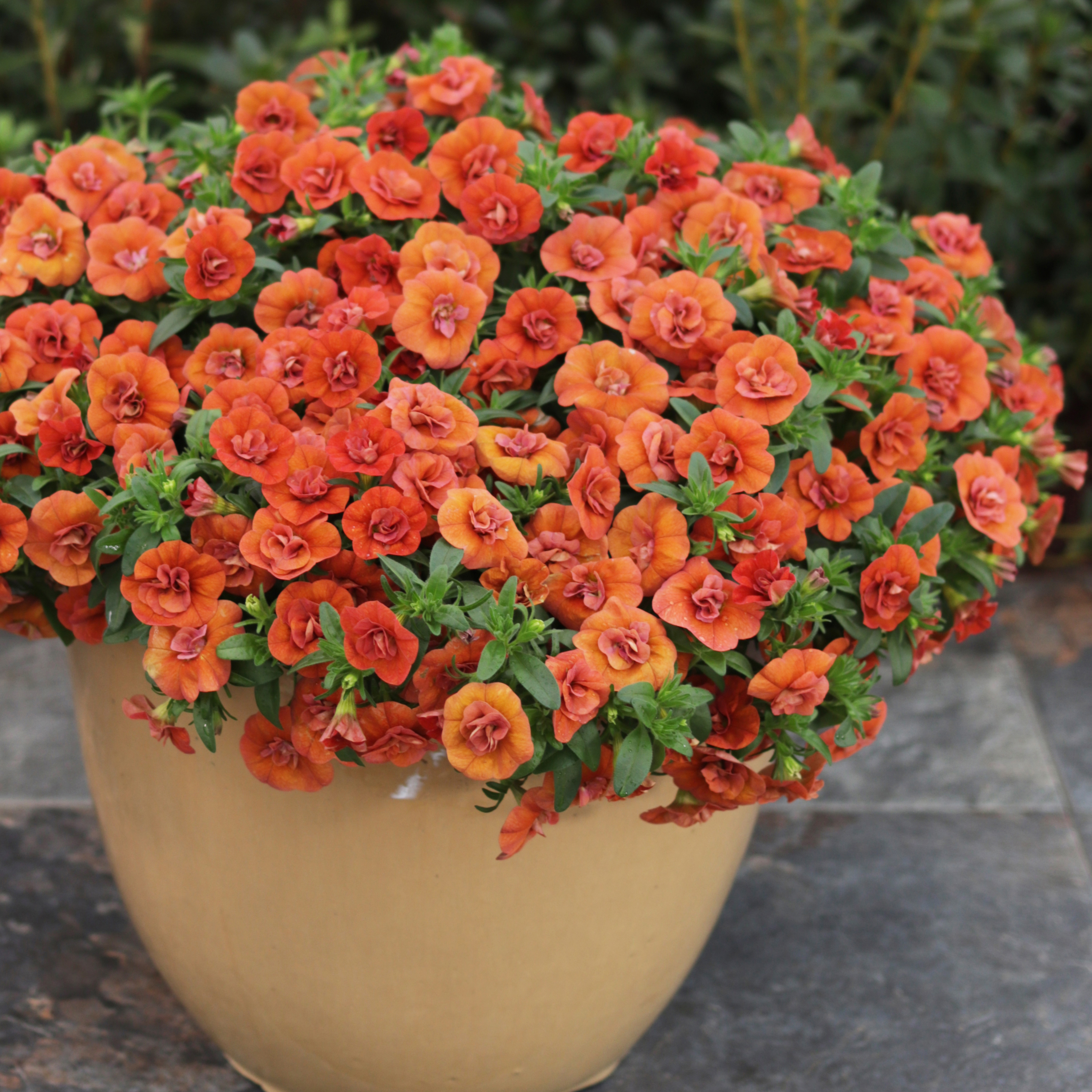
3. Superbells ® Double Orange Calibrachoa
Superbells Double Orange is basically Superbells Dreamsicle with double flowers. It will fall over the edge of your containers adding a nice trailing element, but has enough height to also function as a filler in your planter or basket. If you are not familiar with the Thriller, Filler, Spiller method for creating mixed containers, you can learn more here.
6-12” Tall. Part Sun to Sun. Annual.
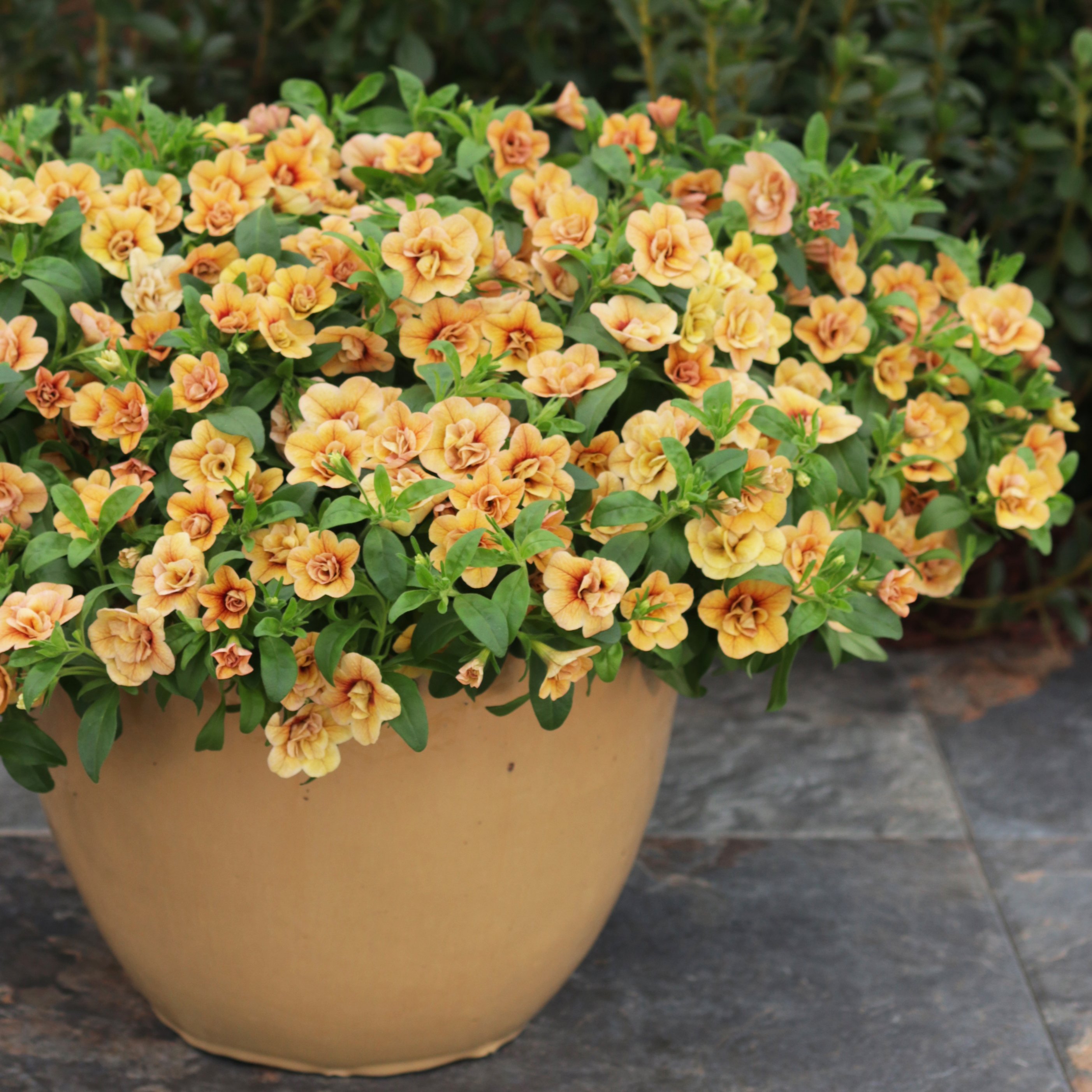
4. Superbells ® Double Amber Calibrachoa
Like Superbells Double Orange, Double Amber has fully double, rose-like flowers. This unique amber-orange color has a soft, soothing tone. The flowers have dark veins and are sometimes suffused with pink radiating from the center of the flowers. If you are looking for the softer side of orange, Double Amber is perfect. The plant is typically buried in flowers that cascade over the edge of the pot.
6-12” Tall. Part Sun to Sun. Annual.

5. Superbells ® Tangerine Punch ™ Calibrachoa
Like the other Superbells options, Tangerine Punch functions as both a filler and a spiller in combination planters and hanging baskets. It offers petals with quite a bit of color interest—the outer edges of the petals are a lovely citrus orange but the middle of the flower is deep velvety black. The contrast between the two colors is very eye-catching. If you’re looking for the perfect Halloween container, mixing Tangerine Punch with ColorBlaze Wicked Hot and Sweet Caroline Bewitched After Midnight would be perfect. This trio will result in a container sporting black and orange foliage and flowers.
6-12” Tall. Part Sun to Sun. Annual.
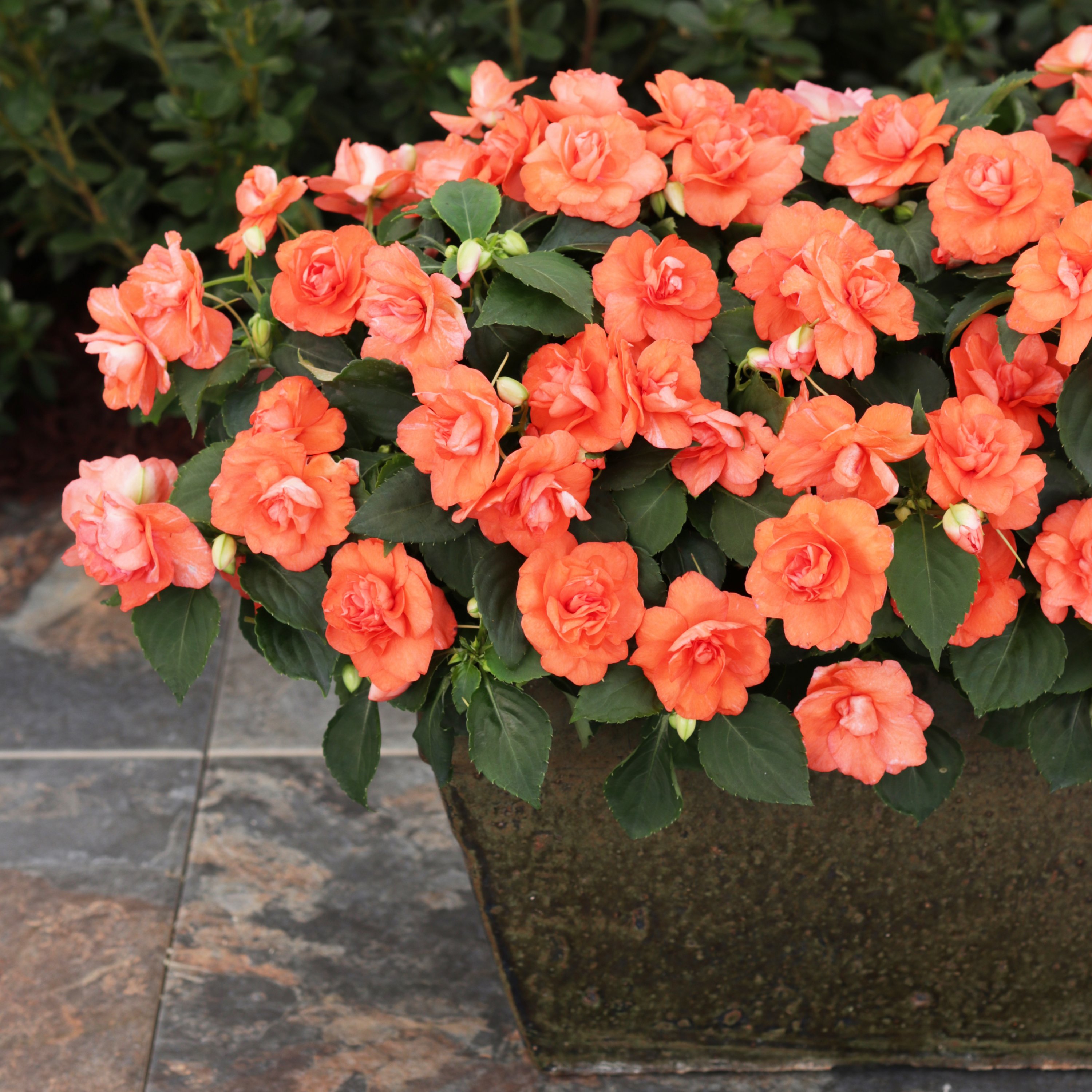
6. Rockapulco ® Orange Shades Impatiens
Shade plants are often ignored, but great plants for shade do exist. Our Rockapulco series of Double Impatiens has a good range of colors, including a wonderful saturated orange. These plants are flowering powerhouses, buried in beautiful rose-like flowers. Combine them with one of our orange ColorBlaze Coleus (see below) and throw in a Sweet Caroline Sweet Potato Vine for a trailing element and you’ll have a gorgeous combination that is perfect for a shady spot.
10-20” Tall. Part Shade to Shade. Annual.

7. ColorBlaze ® Sedona Sunset ® Coleus
The orange foliage of this plant has a bit of a rosy glow to it, which adds depth and richness to the color and lends a brightness to the plant. It is great in both sun and shade and is well suited for containers or landscapes. An easy plant to fall in love with.
24-40” Tall. Sun or Shade. Annual.
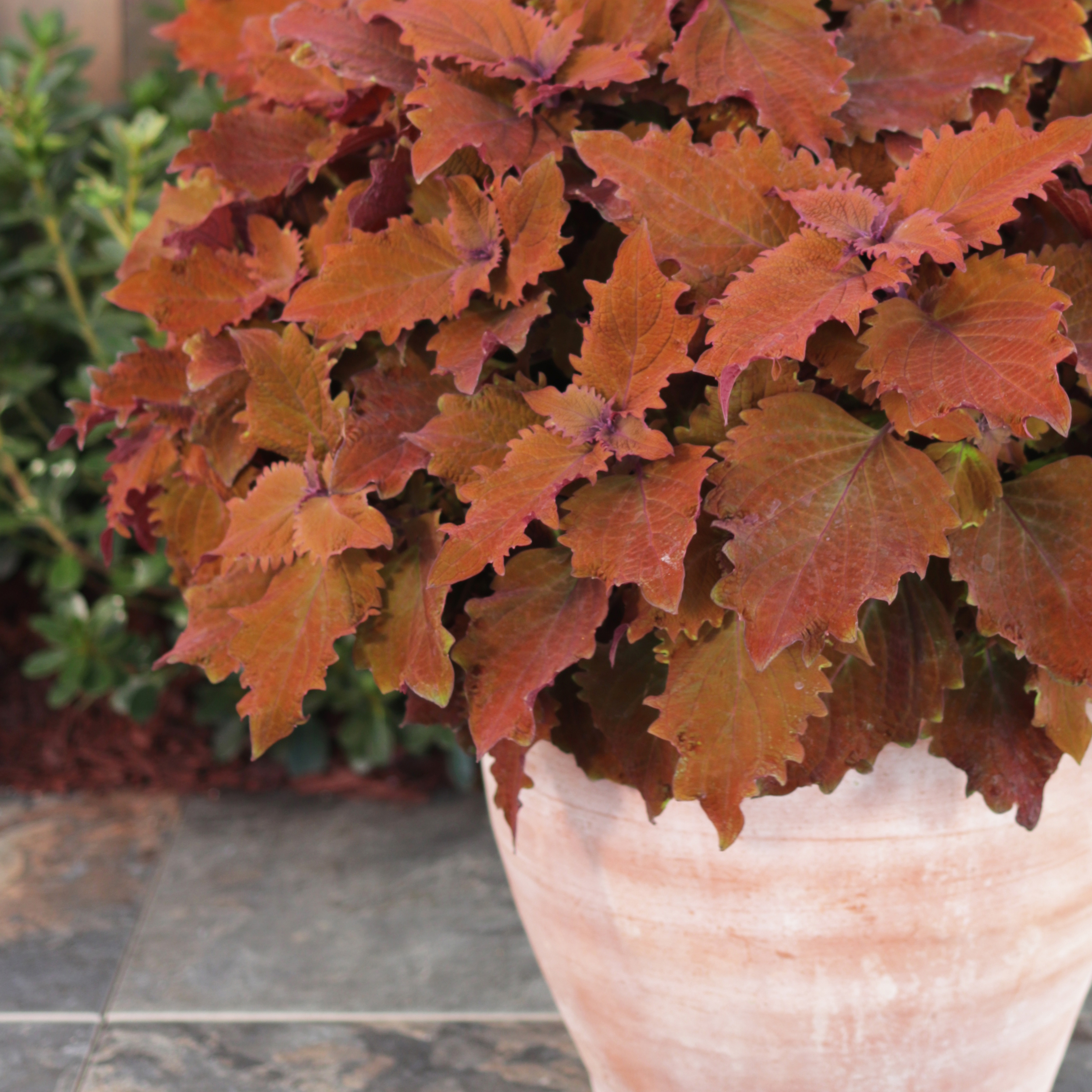
8. ColorBlaze ® Wicked Hot ™ Coleus
I love the coppery-orange of the foliage on this variety and the leaves sport a ruffled, pointed margin. Wicked Hot is great in both sun and shade conditions, which makes it one of the most flexible plants on this list. Plant it in masses or as a focal point in garden beds, or use it as a thriller plant in combination recipes. I love planting it alone in a large container for constant color, with no flowers needed. ColorBlaze varieties have been selected during our breeding process because they tend to not flower, which keeps the foliage looking great all season.
24-40” Tall. Sun or Shade. Annual.

9. Vermillionaire ® Cuphea
Vermillionaire is one of my all-time favorite plants. In fact, I love it enough that I am willing to fight the Japanese Beetle invasion every summer to have them in my garden! Why do I love it so much? First, hummingbirds adore it and Vermillionaire guarantees that I can watch hummingbirds flitting around my deck all summer—my office windows look out onto the deck. The second reason I love it is because butterflies think the plant is great too. But that’s not all! Vermillionaire is heat tolerant, can take some drought stress, and needs almost no input from the gardener. Plus,it works wonderfully in both containers and landscapes. Why wouldn’t you want it?
18-28” Tall. Sun. Annual

10. Luscious ® Marmalade Lantana
Speaking of plants that pollinators love, Luscious Marmalade makes the list. I regularly see all three of the big pollinators visiting this plant. Butterflies and hummingbirds regularly visit and the bees join in too. One of the true joys of my garden is watching and listening to bumblebees. The plant is well-branched, flowers are gathered into large umbels and there are many umbels on each plant. The result is a riot of color and tons of activity as the various pollinators visit one of their favorite places to dine. Beyond that, Lantana is one of the easiest plants to grow. Heat, humidity, drought, blasting sun – every other trial your garden might experience – Marmalade will shrug it off. When other plants are thinking, “man things are getting tough out here” Marmalade is keeping calm and carrying on. I do love a tough durable plant.
20-30” tall. Sun. Annual in most climates.
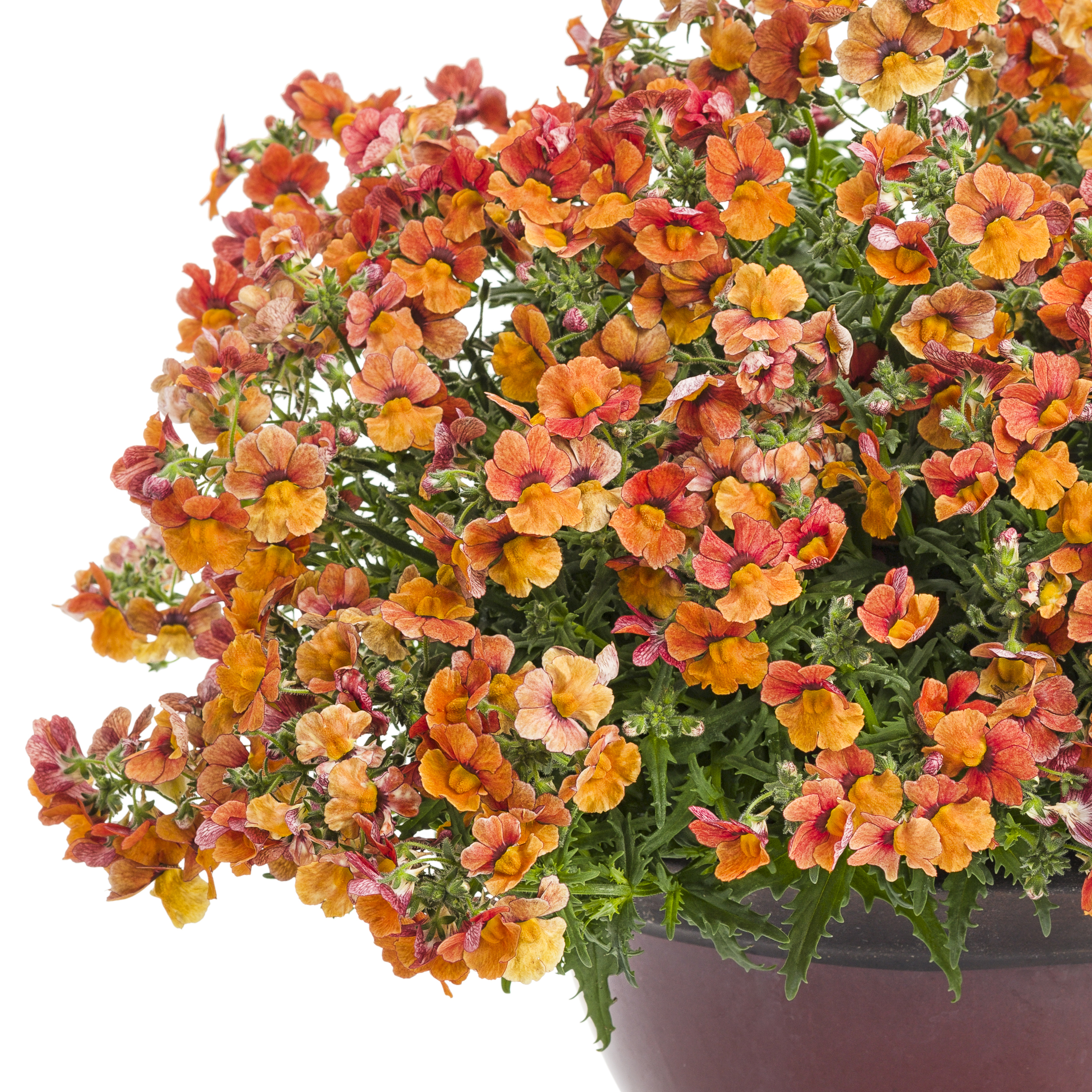
11. Sunsatia ® Blood Orange ™ Nemesia
We often talk about plants that can take the heat, often forgetting the joys of plants that happily tolerate cooler temperatures. In early spring, and as summer turns into fall and temperatures drop, plants that will bloom even after light frosts begin are great additions to your garden. The Sunsatia Nemesias are well suited for spring and late summer through fall gardens. It will shrug off light frost as if it is nothing and combines well with pansies and other cool-season crops.
10-14” Tall. Part Sun to Sun. Annual.

12. Mojave ® Tangerine Portulaca
Mojave Tangerine reminds me of the color of orange sorbet. The color might be cool, but the plant loves heat and is tough as nails. Plant it in full sun, supply some water if needed, but this is a pretty low input plant. In landscape beds, it will be quite drought tolerant, and not very water needy. In containers, water has to be regularly supplied just like any container. It’s another tough and durable plant to consider.
4-8” Tall. Sun. Annual.

13. Orange A-Peel ® Thunbergia
The A-Peels are one of the more unique plants we offer to gardeners. The common name for these plants is black-eyed Susan vines, and these orange flowers with the dark brown-to-black eye mimic rudbeckia, also known as black-eyed Susans. This color is the most common as well. I love that these are annual vines so you can enjoy all season without worrying that their roots will damage the structure of your home. Growing these on a trellis as a climbing vine is one great way to enjoy this variety, but there are other creative ways to consider as well. I’ve seen them used to create a Teepee, which would be fun for kids of all ages.
6-8’ Tall. Part Sun to Sun. Annual Vine.
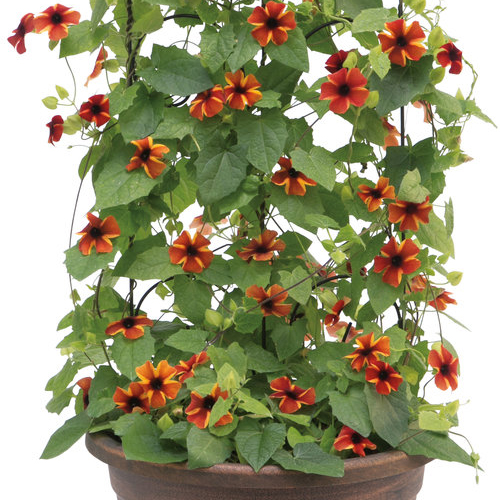
14. Tangerine Slice A-Peel ® Thunbergia
Tangerine Slice A-Peel is our most unique color, offering a pinwheel effect of red-orange and peach flowers. Using a trellis is again an option, but another is to plant Tangerine Slice A-Peel in your hanging basket. It will climb the chains and create height and also trail over the side. Go light with the plant food to ensure better blooming. You can feed them, but keep them a little bit hungry to get the best bloom for your buck.
6-8’ Tall. Part Sun to Sun. Annual Vine.
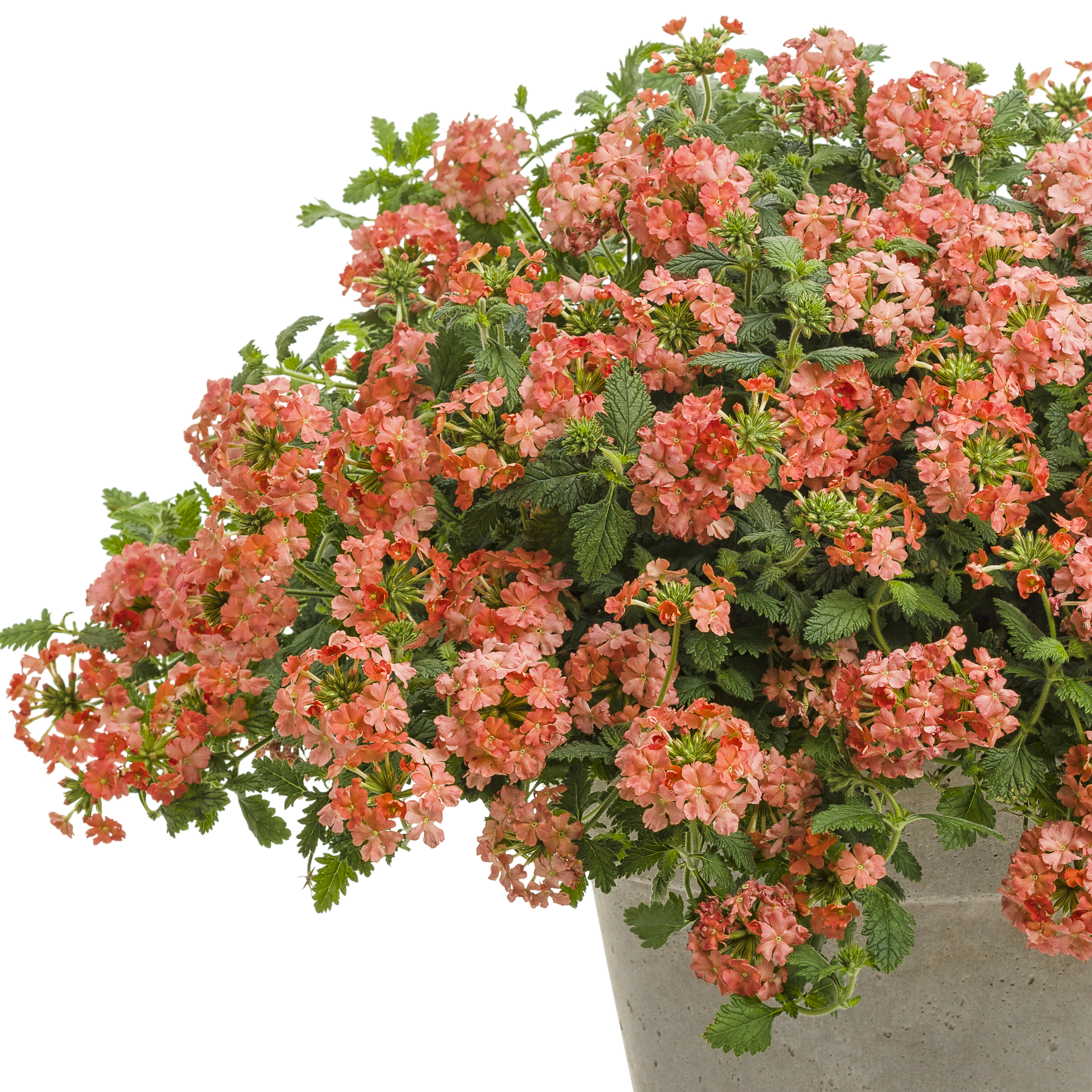
15. Superbena ® Peachy Keen Verbena
The tendency with orange is to think of bright, rich, hot colors, while ignoring the softer side of the color group. Peachy Keen is the perfect plant to consider if you would like to use orange, but you don’t want it to be an ‘in your face’ type of color. This soft peachy color ranges from a pale blush to a nice peach tone that is a little bit on the pink side. It pairs perfectly with other soft colors. It is the perfect tone to use if you are looking to create a quiet oasis for contemplation.
6-12” Tall. Part Sun to Sun. Annual.

This English marigold has large colorful flowers with great heat tolerance. Fully double flowers mean less seed set and fewer seedlings trying to take over your garden. Plant them in containers and landscapes. Easy to maintain with no deadheading necessary.
10-16″ tall. Part Sun to Sun. Annual.
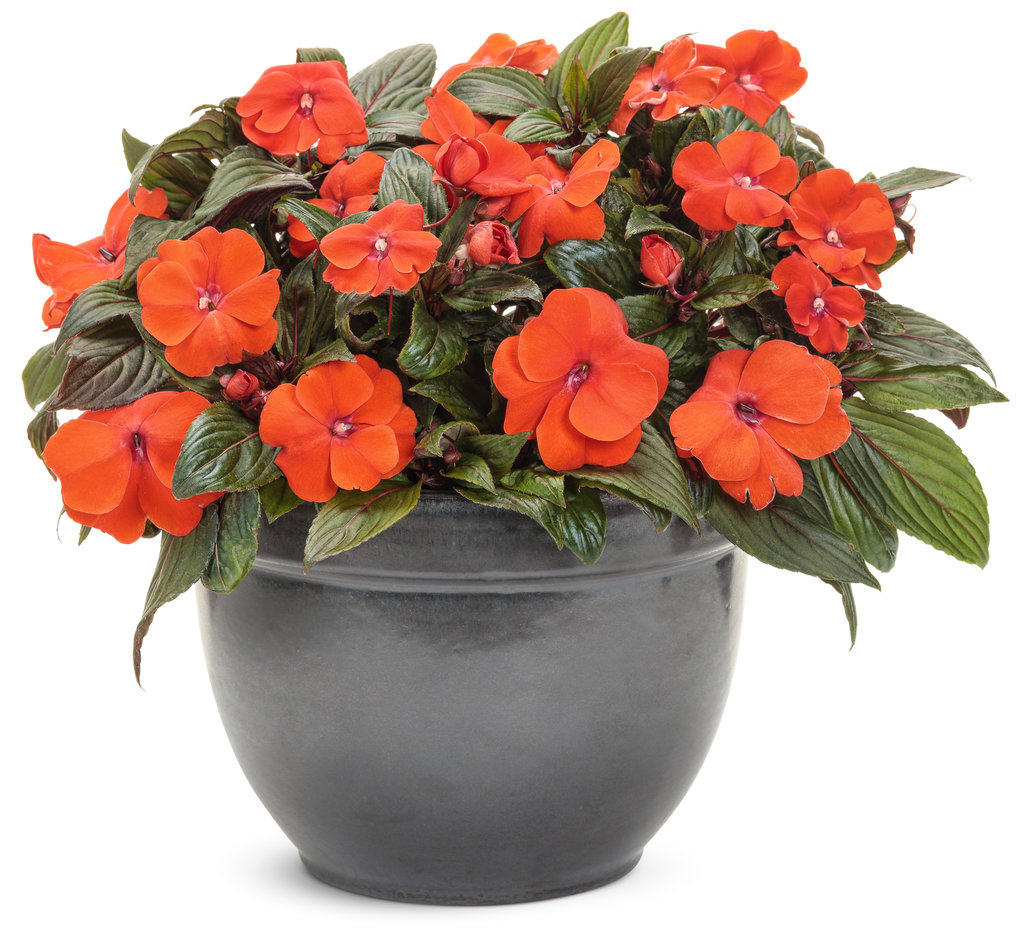
17. Infinity ® Orange Impatiens
Need great flowering color for shaded areas? Infinity ® Orange is a vigorous, upright plant with large flowers. Along with being pretty, they are resilient and need little to no maintenance.
10-14″ tall. Part Shade to Shade. Annual.
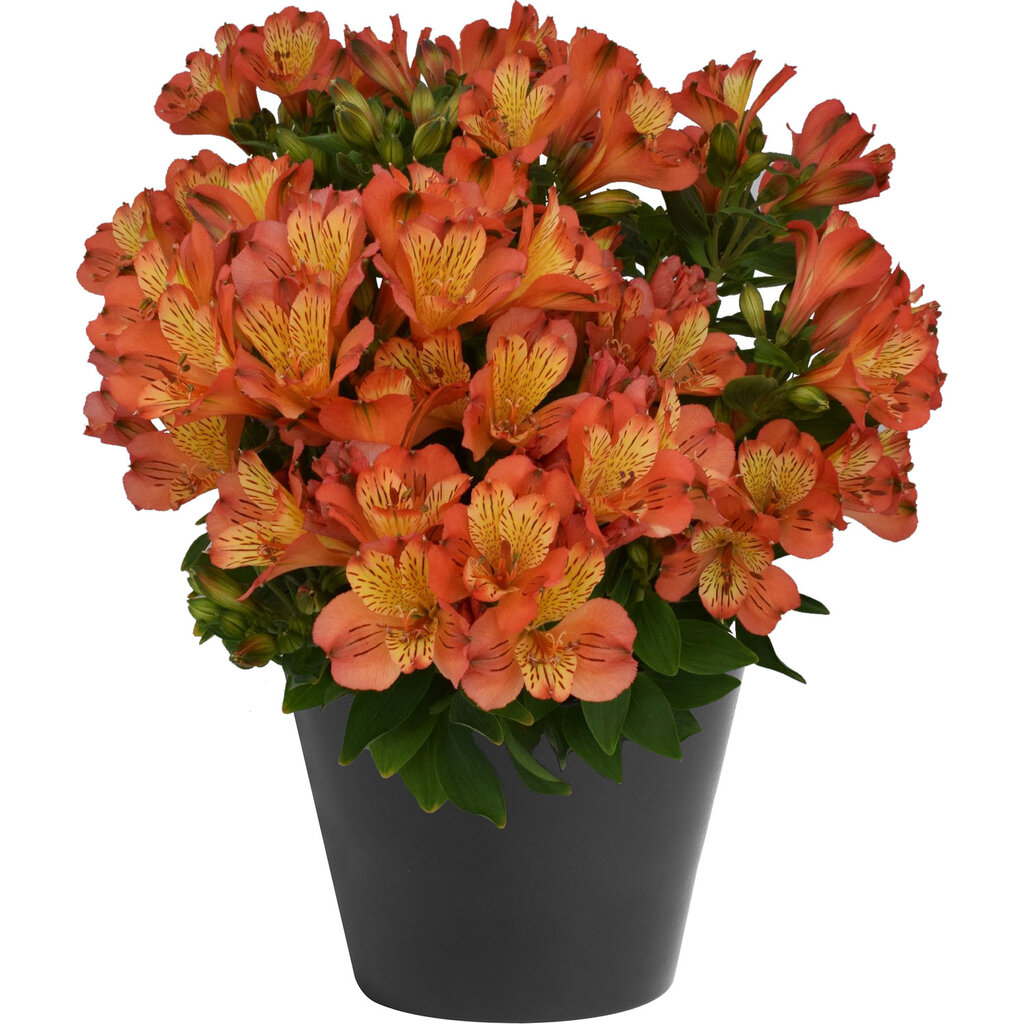
18. Inca Safari ™ Alstroemeria
This Peruvian lily has bright orange flowers with pink undertones and speckled yellow centers. This is a tough, compact garden plant that flowers from spring through to autumn. Bonus: You can use the flowers as cut flowers!
10-14″ tall. Part Sun to Sun. Perennial. Hardy in zones 6-9.
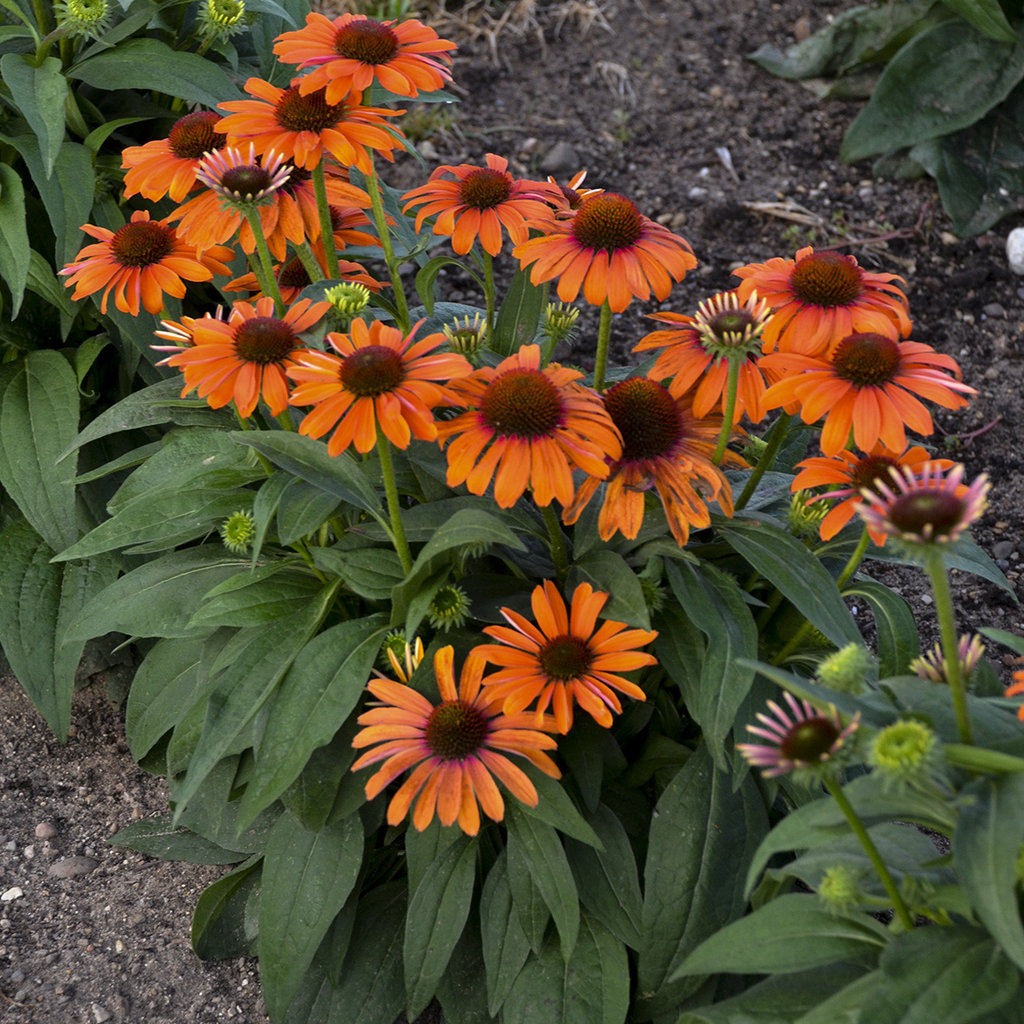
19. Color Coded ® ‘Orange You Awesome’ Echinacea
This coneflower wows with large, tangerine orange flowers and dark cones produced above dark green leaves. I suggest you leave the flower heads intact into winter to watch birds come to eat! Grow in sunny and hot locations with well-drained soils. Tolerates light shade, but best performance is in full sun. Drought tolerant once established.
18-22″ tall. Part Sun to Sun. Perennial. Hardy in zones 4-8.
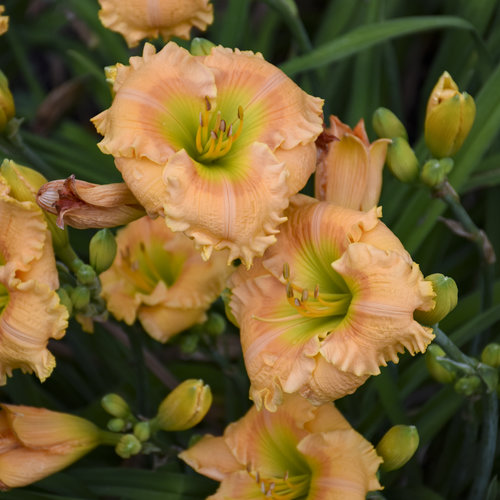
20. Rainbow Rhythm ® ‘Orange Smoothie’ Hemerocallis
A daylily with orange-mango petals with a light rose band, borne on strong, well-branched, heavily budded scapes. Flowers appear in midsummer and again later in the season. A tough, adaptable perennial that will grow in almost any soil. Plant in full sun for optimum flowering performance.
2′ tall and wide. Part Sun to Sun. Perennial. Hardy in zones 3-9.
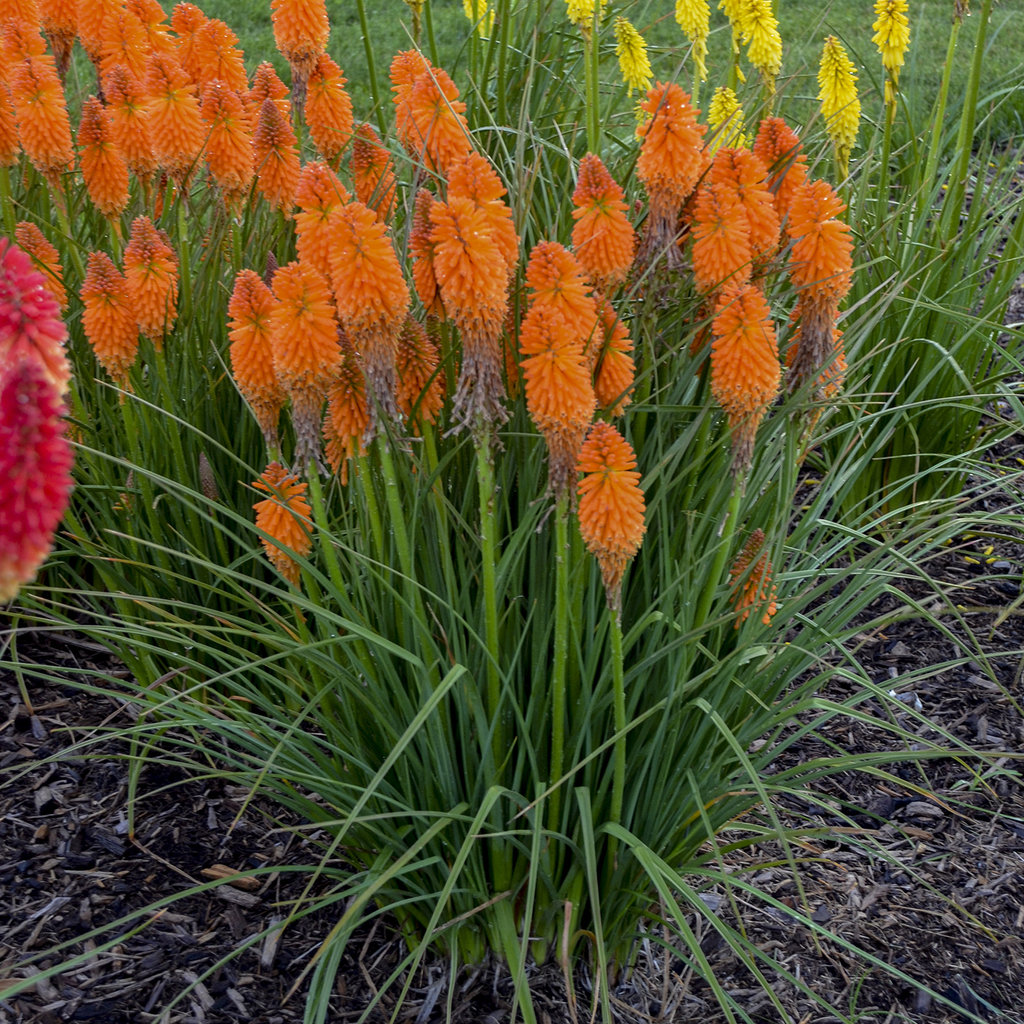
21. Pyromania ® ‘Orange Blaze’ Kniphofia
Bring unique drama to your landscape with the spiky flowers and upright habit of this red hot poker. Bright orange flowers are produced over grass-like foliage.
2-3′ tall. Full Sun. Perennial. Hardy in zones 5-9.
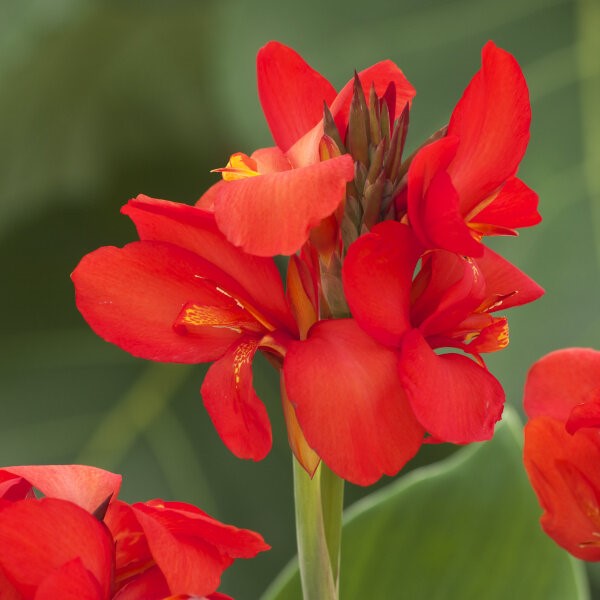
22. Toucan ® Dark Orange Canna
This deep orange canna lily will bloom all summer, it is extremely heat tolerant – loving both heat and humidity. They are adaptable and can take damp conditions, but they are not especially water needy. Use these plants as the thriller in large combinations or in the landscape to lend a tropical feel to your garden.
2’6″-4′ tall. Part Sun to Sun. Annual.
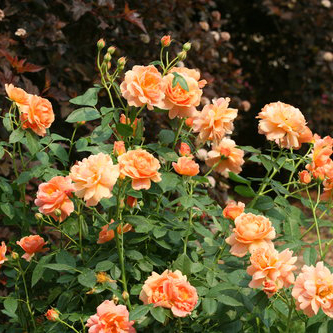
23. At Last ® Rosa
Enjoy a non-stop display of large, sweetly perfumed sunset-orange blossoms from late spring through frost. Since this rose won’t need spraying or deadheading, it’s very easy to grow.
2’6″-3′ tall. Full Sun. Shrub. Hardy in zones 5-9.
Learn More
Learn How to Use Orange in your landscape.
Entice hummingbirds to your garden with Vermillionaire ® .